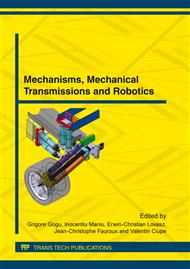[1]
Z. M. Bi, Y. T. Lang, M. Verner, P. Orban, Development of reconfigurable machines, Int. J. Adv. Manuf. Technol, 39 (2007) 1227-1251.
DOI: 10.1007/s00170-007-1288-1
Google Scholar
[2]
I-M. Chen, G. Yang, S.H. Yeo, Automatic Modeling for Modular Reconfigurable Robotic Systems – Theory and Practice, in Sam Cubero (Ed. ), Industrial Robotics: Theory, Modelling and Control, (2006) 43-81.
DOI: 10.5772/5017
Google Scholar
[3]
A.K. Dash, I-M. Chen, S.H. Yeo, G. Yang, Task – Oriented Configuration for Reconfigurable Parallel Manipulator Systems, International Journal of Computer Integrated Manufacturing, 18 (2005) 615-634.
DOI: 10.1080/09511920500069192
Google Scholar
[4]
X. Ping, X.J. Zhu, Y. Q. Fei, Mechanical Design and Locomotion Control of a Homogenous Lattice Modular Self-Reconfigurable Robot, Journal of Zhejian University – Science A, 7 (2006) 368-373.
DOI: 10.1631/jzus.2006.a0368
Google Scholar
[5]
S. Behnam, M. Moll, W.M. Shen, A Deployable, Multi-Functional, and Modular Self-Reconfigurable Robotic System, Proceedings of the 2006 IEEE/RSJ International Conference on Intelligent Robots and Systems, China, (2006).
DOI: 10.1109/iros.2006.281719
Google Scholar
[6]
Y. Zhang, C. Eldershaw, M. Yim, K. Roufas, D. Duff, A platform for Studying Locomotion systems: Modular reconfigurable Robots, NIST W. on Performance Metrics for Int. Syst (2002).
Google Scholar
[7]
Z. M. Bi, L. Wang, Optimal design of Reconfigurable Parallel Machining Systems, Robotics and Computer – Integrated Manufacturing, 25 (2009) 951 -961.
DOI: 10.1016/j.rcim.2009.04.004
Google Scholar
[8]
D. Finistauri, F. Xi, B. Petz, Architecture design and Optimization of an On-the-Fly Reconfi-gurable Parallel Robot, Parallel Manipulators, Towards New Applications, (2008) 379-404.
DOI: 10.5772/5440
Google Scholar
[9]
G. Gogu, Isogliden TaRb: a Family of up to Five Axes Reconfigurable and Maximally Regu-lar Parallel Kinematic Machines, Int. Conf. on Smart Machining Systems, (2007).
Google Scholar
[10]
G. Yang, I. -M. Chen, W.K. Lim, S.H. Yeo, Design and Kinematic Analysis of Modular Reconfigurable Parallel Robots, Proceedings of the 1999 IEEE International Conference on Robotics & Automation, 4 (1999) 2501-2506.
DOI: 10.1109/robot.1999.773973
Google Scholar
[11]
Mărgineanu, D., Lovasz, E. -C., Modler, K -H., Perju, D., Noll, C., Mandiuc, M., On the 3D Crawling Mechanical Structure. 12th IFToMM World Congress, Besançon (France). (2007).
Google Scholar
[12]
E. Colon, P. Alexandre, J. Weemaels, I. Doroftei, Development of a high mobility wheeled robot for humanitarian mine clearance, SPIE Conference on Robotic and Semi-Robotic Ground Vehicle Technology , DOI: 10. 1117/12. 317539, 3366 (1998) 100-107.
DOI: 10.1117/12.317539
Google Scholar
[13]
J. Choi, et. al., Dynamic and stable reconfiguration of self-reconfigurable planar parallel robots, Advanced Robotics, 18 (2004) 565-582.
DOI: 10.1163/1568553041257440
Google Scholar
[14]
D. Pisla, N. Plitea, A. Vidrean, B. Prodan, D. Lese, Kinematics and Design of Two Variants of a Reconfigurable Parallel Robot, Reconfigurable Mechanisms and Robots, REMAR, (2009) 565-572.
DOI: 10.1007/978-90-481-3522-6_47
Google Scholar
[15]
N. Plitea, et. al. Parallel robot family with six degrees of freedom, Patent nr. A/10013/(2011).
Google Scholar
[16]
D-B. Lese, N. Plitea, Modeling of a Parallel Reconfigurable Robot with Six Degrees of Mobility and Its Configurations with Five, Four, Three and Two Degrees of Mobility, Acta Tehnica Napocensis, Applied Mathematics and Mechanics, 54(1) (2011).
DOI: 10.4028/www.scientific.net/amm.162.204
Google Scholar
[17]
Plitea, N., Hesselbach, J., Pisla, D., Raatz, A., Vaida, C., Simnofske, M., Prodan, B., Burisch A., Vidrean A., Modeling of parallel microrobots with two to six degrees of freedom, Acta Technica Napocensis, Series: Machines Construction. Materials, 50 (2007).
DOI: 10.1002/pamm.200700781
Google Scholar


